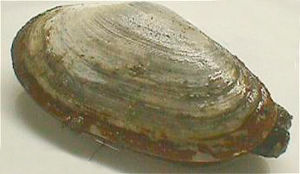Heterodonta
| Heterodonta | ||||||||||
|---|---|---|---|---|---|---|---|---|---|---|

Sand gape clam ( Mya arenaria ) |
||||||||||
| Systematics | ||||||||||
|
||||||||||
| Scientific name | ||||||||||
| Heterodonta | ||||||||||
| Neumayr , 1883 |
The heterodonta (also called different-toothed or alternate-toothed mussels in German) are a large group of mussels (bivalvia), which in the more recent classifications is listed as a superordinate group within the autolamellibranchiata . It is a large, very diverse group of mussels found in many habitats. It is considered to be the sister group of the Palaeoheterodonta . The first mussels that can be assigned to this group appear in the Middle Ordovician .
characterization
The housings of the heterodonta are very diverse. They can be equilateral (bilateral symmetrical), unevenly hinged (asymmetrical) or aberrant (e.g. Hippuritoida). The shells are aragonitic with cross-lamellar or prismatic microstructures. There are no pearlescent microstructures. With the Hippuritoida layers with fibrous-prismatic calcite crystals are deposited on the outer prismatic layer . The lock is originally heterodontic , but can also be greatly enlarged (pachydont) or reduced; or be transformed into a demodontic lock. The ligament is external.
The heterodonta are isomyar , i. H. the two sphincters are approximately the same size, anisomyar (unequal size) or monomyar, i.e. H. the originally two sphincters have fused to form one sphincter. The foot is usually well developed, and in some taxa it can be reduced. It is usually used for digging, crawling and, more rarely, for drilling. The siphons can be quite large in digging forms. The gills are owl lamella branchchiate.
Way of life
The heterodonta are predominantly marine mussels that have developed a very wide range of habitats. A few superfamilies have also penetrated into brackish and fresh water. Other forms were only recently discovered near so-called black smokers in the deep sea. There are forms that dig themselves into soft sediments to different depths, drill into hard substrates, have grown with a goblet-like flap and presumably lived in symbiosis with algae (Hippuritoida), the shell almost completely reduced and crawling around like nudibranchs. The heterodonta have the largest spectrum of forms and ways of life within the mussels. Most species feed on "mussel-typical" filter feeders . There are also some forms that breed bacteria. The extinct Hippuritoida very likely lived in symbiosis with photosynthesis-driving organisms.
Systematics
The Heterodonta are considered in the cladistics as the sister group of the Palaeoheterodonta. The systematics has changed in the most recent work insofar as the superfamily Carditoidea (order Venerida) was raised to the rank of order, while the previous superorder Anomalodesmata was "degraded" to the order level. This downgrade is not yet followed here:
- Order Cardiida Férussac, 1822
- Order Carditida Dall , 1889 (this order is not yet recognized by the Zoological Record and the majority of malacologists, the group is usually managed as a superfamily of the order Venerida )
- Order Myida Stoliczka , 1870
- Order † Hippuritoida Newell , 1965
- Order Venerida H. Adams & A. Adams , 1856
- (Order Anomalodesmata Dall , 1889; this order is considered by most of the investigators as a superordinate or even a subclass. Harper et al. (2006) advocate a downgrading to order)
literature
- Michael Amler, Rudolf Fischer & Nicole Rogalla: Mussels . Haeckel library, volume 5. Enke Verlag, Stuttgart 2000 ISBN 3-13-118391-8 .
- Rüdiger Bieler & Paula M. Mikkelsen: Bivalvia - a look at the branches . Zoological Journal of the Linnean Society, 148: 223-235, London 2006.
- Elisabeth M. Harper, Hermann Dreyer & Gerhard Steiner: Reconstructing the Anomalodesmata (Mollusca: Bivalvia): morphology and molecules . Zoological Journal of the Linnean Society, 148: 395-420, London 2006
Web links
Individual evidence
- ↑ Heterodonta at: staticip.de ( Memento of the original from April 3, 2004 in the Internet Archive ) Info: The archive link was inserted automatically and has not yet been checked. Please check the original and archive link according to the instructions and then remove this notice.
- ↑ Terminology / mussels at: lutzhoepner.de ( Memento of the original from July 22, 2007 in the Internet Archive ) Info: The archive link was inserted automatically and has not yet been checked. Please check the original and archive link according to the instructions and then remove this notice.